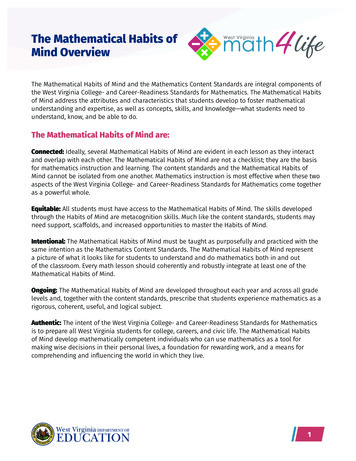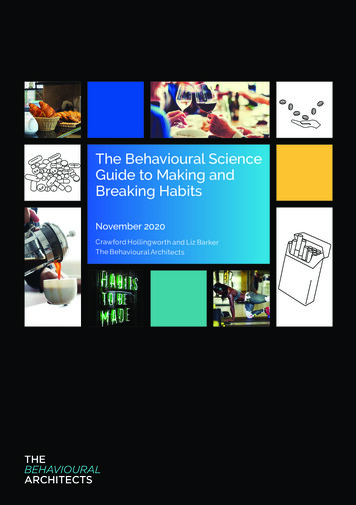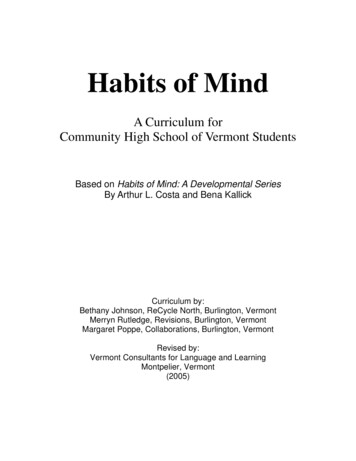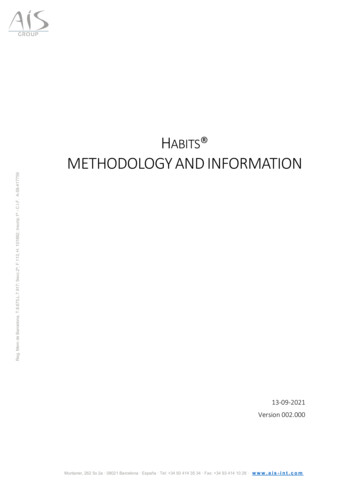
Transcription
The Mathematical Habits ofMind OverviewThe Mathematical Habits of Mind and the Mathematics Content Standards are integral components ofthe West Virginia College- and Career-Readiness Standards for Mathematics. The Mathematical Habitsof Mind address the attributes and characteristics that students develop to foster mathematicalunderstanding and expertise, as well as concepts, skills, and knowledge—what students need tounderstand, know, and be able to do.The Mathematical Habits of Mind are:Connected: Ideally, several Mathematical Habits of Mind are evident in each lesson as they interactand overlap with each other. The Mathematical Habits of Mind are not a checklist; they are the basisfor mathematics instruction and learning. The content standards and the Mathematical Habits ofMind cannot be isolated from one another. Mathematics instruction is most effective when these twoaspects of the West Virginia College- and Career-Readiness Standards for Mathematics come togetheras a powerful whole.Equitable: All students must have access to the Mathematical Habits of Mind. The skills developedthrough the Habits of Mind are metacognition skills. Much like the content standards, students mayneed support, scaffolds, and increased opportunities to master the Habits of Mind.Intentional: The Mathematical Habits of Mind must be taught as purposefully and practiced with thesame intention as the Mathematics Content Standards. The Mathematical Habits of Mind representa picture of what it looks like for students to understand and do mathematics both in and outof the classroom. Every math lesson should coherently and robustly integrate at least one of theMathematical Habits of Mind.Ongoing: The Mathematical Habits of Mind are developed throughout each year and across all gradelevels and, together with the content standards, prescribe that students experience mathematics as arigorous, coherent, useful, and logical subject.Authentic: The intent of the West Virginia College- and Career-Readiness Standards for Mathematicsis to prepare all West Virginia students for college, careers, and civic life. The Mathematical Habitsof Mind develop mathematically competent individuals who can use mathematics as a tool formaking wise decisions in their personal lives, a foundation for rewarding work, and a means forcomprehending and influencing the world in which they live.1
Mathematical Habit of Mind 8 – Look for and expressregularity in repeated reasoning.This document combines information from several sources into one in-depth look at MathematicalHabit of Mind 8.Mathematical Habits of Mind in PolicyThe following exert is from WV Policy 2510: The Mathematical Habits of Mind (hereinafter MHM) describe varieties of expertise thatmathematics educators at all levels should develop in their students.MHM8. Look for and express regularity in repeated reasoning.Mathematically proficient students notice if calculations are repeated and look both for generalmethods and for shortcuts. Upper elementary students might notice when dividing 25 by 11 that theyare repeating the same calculations over and over again, and conclude they have a repeating decimal.By paying attention to the calculation of slope as they repeatedly check whether points are on theline through (1, 2) with slope 3, middle school students might abstract the equation (y – 2)/(x – 1) 3.Noticing the regularity in the way terms cancel when expanding (x – 1)(x 1), (x – 1)(x2 x 1) and(x – 1)(x3 x2 x 1) might lead them to the general formula for the sum of a geometric series. As theywork to solve a problem, mathematically proficient students maintain oversight of the process, whileattending to the details. They continually evaluate the reasonableness of their intermediate results.2
Overview of MHM8 – What it is, What it does, and What it looks likeMHM8. Look for and express regularity in repeated reasoning.What it isWhat it doesWhat it looks likeShowing studentshow a problem works,looking at shortcuts,repeated calculations,and attending todetails.Allows students to take theirStudents:Teacher:mathematical reasoning, apply it to Notice if calculations are repeated Provides problem situations thatother situations, and generalize toand look for both general methodsallow students to explore regularityother problem types.and shortcuts.and repeated reasoning. See repeated calculations and look Pay attention to regularity and use Provides rich tasks that encouragefor generalizations and shortcuts.it to solve problems.students to use repeated See the overall process of the Use regularity to develop a generalreasoning to form generalizationsproblem and still attend to theformula and generalizations.and provides opportunities fordetails in the problem-solving Maintain oversight of the process ofstudents to communicate thesesteps.solving a problem while attendinggeneralizations. Understand the broader applicationto details and continually evaluateof patterns and see the structure inthe reasonableness of immediatesimilar situations.results. Continually evaluate thereasonableness of theirintermediate results.3
Developing Mathematical Habits of Mind through Questions and Expressing in Student-FriendlyLanguageThe following chart includes both the MHM in student-friendly language and examples of questions teachers might use to supportmathematical thinking and student engagement.Mathematical Habit of MindMHM Expressed inStudent-Friendly LanguageQuestions to DevelopMathematical ThinkingMHM8.Look for and expressregularity in repeatedreasoning.I can use a strategy I used to solve another mathproblem. I can notice repeated calculations anduse them to create shortcuts. Explain how this strategy works in other situations.Is this always true, sometimes true, or never true?How would we prove that ?What do you notice about ?What is happening in this situation? What wouldhappen if ?Is there a mathematical rule for ?What predictions or generalizations can this patternsupport?What mathematical consistencies do you notice?How is this situation like and different from othersituations using this operation?4
Rubric – Implementing Mathematical Habits of MindUse the Task descriptors in developing lessons to ensure that classroom tasks help cultivate the MHMs. The teacher descriptors canbe used during or after the lesson to evaluate how the task was carried out. The column titled “Proficient” describes the expectednorm for task and teacher action, while the column titled “Exemplary” includes all features of the proficient column and more. A task isexemplary when meeting criteria in both the proficient and exemplary columns.MHM8DESCRIPTORTaskLook forand expressregularityin repeatedreasoning.TeacherNEEDS IMPROVEMENTEMERGINGPROFICIENTEXEMPLARY(teacher does the thinking)(teacher mostly models)(students take ownership) Is disconnected fromprior and futureconcepts. Has no logicalprogression that leadsto pattern recognition. Is overly repetitive orhas gaps that do notallow for developmentof a pattern. Reviews priorknowledge andrequires cumulativeunderstanding. Lends itself todeveloping a patternor structure. Addresses andconnects to priorknowledge in a nonroutine way. Requires recognitionof pattern or structureto be completed. Does not showevidence ofunderstanding thehierarchy withinconcepts. Presents or examinestask in isolation. Hides or does notdraw connectionsto prior or futureconcepts. Connects conceptto prior and futureconcepts to helpstudents developan understanding ofprocedural shortcuts. Demonstratesconnections betweentasks. Encourages studentsto connect task toprior concepts andtasks. Prompts students togenerate exploratoryquestions based oncurrent task. Encourages studentsto monitor eachother’s intermediateresults.5
The Vertical Progression of the Mathematical Habit of Mind 8The Mathematical Habits of Mind are an integral part of the West Virginia College- and CareerReadiness Standards for Mathematics. This Vertical Progression document has taken grade specificinformation about the Mathematical Habits of Mind from the West Virginia Educators’ Guides forMathematics to display how the Habits of Mind develop and grow from Kindergarten to High School.The document also showcases the similarities of the Habits of Mind at each grade level.MHM8 – Look for and express regularity in repeated reasoning.KindergartenStudents: notice repetitive actions in counting, computations, and mathematical tasks. For example:» the next number in a counting sequence is 1 more when counting by ones,» 10 more when counting by tens (or 1 more group of 10). should be given problems like:» “There are 8 crayons in the box. Some are red and some are blue. How many of eachcould there be?”» realize 8 crayons could include 4 of each color (8 4 4), 5 of one color and 3 of another(8 5 3), and so on.» For each solution, students repeatedly engage in the process of finding two numbers tojoin together to equal 8.Grade 1Students: Grade 2Students: notice repetitive actions in counting and computation (e.g., number patterns to count bytens or hundreds). check for the reasonableness of solutions during and after completion of a task by askingthemselves, “Does this make sense?”Grade 3Students: notice repetitive actions in computations and look for “shortcut” methods. use the distributive property as a strategy to work with products of numbers they know tosolve products they do not know. For example:» to find the product of 7 8, decompose 7 into 5 and 2 and then multiply 5 8 and 2 8 toarrive at 40 16, or 56. evaluate work by asking, “Does this make sense?”notice repetitive actions in counting and computation.gain a better understanding of place value.check work by asking, “Does this make sense?”begin to look for regularity in problem structures when solving mathematical tasks. Forexample:» add three one-digit numbers by using strategies such as “make a ten” or doubles. recognize when and how to use strategies to solve similar problems. For example:» when evaluating 8 7 2, a student may say, “I know 8 and 2 equals 10, then I add 7 to getto 17. It helps if I can make a ten out of two numbers when I start.” use repeated reasoning while solving a task with multiple correct answers. For example:» “There are 12 crayons in the box. Some are red and some are blue. How many of eachcolor could there be?”» use repeated reasoning to find pairs of numbers that add up to 12 (e.g., the 12 crayonscould include 6 of each color [6 6 12], 7 of one color and 5 of another[7 5 12], and so on).6
Grade 4Students: notice repetitive actions in computation to make generalizations. use models to explain calculations and understand how algorithms work. examine patterns and generate algorithms. For example:» use visual fraction models to write equivalent fractions.Grade 5Students: use repeated reasoning to understand algorithms and make generalizations about patterns. connect place value and prior work with operations to understand and use algorithmsto extend multi-digit division from one-digit to two-digit divisors and to fluently multiplymulti-digit whole numbers. use various strategies to perform all operations with decimals to hundredths. explore operations with fractions with visual models and begin to formulate generalizations.Grade 6Students: use repeated reasoning to understand algorithms and make generalizations about patterns. make use of opportunities to solve and model problems designed to support generalizingthrough noticingand construct other examples and models that confirmgeneralizations. connect place value and prior work with operations to understand algorithms to fluentlydivide multi-digit numbers. perform all operations with multi-digit decimals. begin to make connections between covariance, rates, and representations that show therelationships between quantities.Grade 7Students: use repeated reasoning to understand algorithms and make generalizations about patterns. notice that if and only if ad bc and construct other examples and models thatconfirm generalizations.Grade 8Students: use repeated reasoning to understand the slope formula and to make sense of rational andirrational numbers. through modelling linear relationships, notice the slope of the graph of the linearrelationship and the rate of change of the associated function are the same. For example:» after repeatedly checking whether points are on the line with a slope of 3 go through thepoint (1, 2), abstract the equation of the line in the form. divide to find decimal equivalents of rational numbers (e.g.,) and generalizeobservations. use iterative processes to determine more precise rational approximations for irrationalnumbers.Algebra I andMath IStudents: realize the key feature of a line in the plane is an equal difference in outputs over equalintervals of inputs, and the result of evaluating the expression (y2-y1)/(x2-x1) for points on theline is always equal to a certain number m. Therefore, if (x, y) is a generic point on this line,the equationGeometryandMath IIStudents:will give a general equation of the line. explore rotations, reflections, and translations, noticing some attributes of shapes (e.g.,parallelism, congruency, orientation) remain the same. develop properties of transformations by generalizing these observations.7
Algebra IIandMath IIIStudents: observe patterns in geometric sums—for example, the first several sums of the formcan be written as follows:8
Habit of Mind 8. Mathematical Habits of Mind in Policy The following exert is from WV Policy 2510: The Mathematical Habits of Mind (hereinafter MHM) describe varieties of expertise that mathematics educators at all levels should develop in their students. MHM










